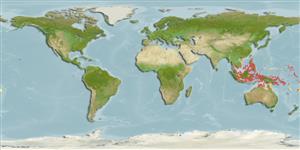Common names from other countries
>
Kurtiformes (Nurseryfishes, cardinalfishes.) >
Apogonidae (Cardinalfishes) > Apogoninae
Etymology: nanus: Name from Latin 'nanus' meaning dwarf, referring to its size being one of the smallest in the genus..
More on authors: Allen, Kuiter & Randall.
Environment: milieu / climate zone / depth range / distribution range
Ecologia
marino associati a barriera corallina; distribuzione batimetrica 3 - 20 m (Ref. 48635). Tropical
Western Central Pacific: Madang, Papua New Guinea; Maumere, Indonesia; and, near Kota Kinabalu, Sabah, Malaysia.
Size / Peso / Age
Maturity: Lm ? range ? - ? cm
Max length : 6.0 cm SL maschio/sesso non determinato; (Ref. 48635)
Short description
Chiavi di identificazione | Morfologia | Morfometria
Spine dorsali (totale) : 7; Raggi dorsali molli (totale) : 9; Spine anali: 2; Raggi anali molli: 8; Vertebre: 24. This species is distinguished by having D VI-I,9; A II,8; pectoral rays 13; lateral line scales 24; predorsal scales 5; gill rakers 7 or 8+20 or 21, excluding an indistinct rudiment on upper limb; preopercular margin serrate; preopercular ridge smooth; body depth 3.4-3.7 in SL; semi-transparent in life with golden-brown midlateral strip, bordered below by narrow silver stripe; tip of lower jaw blackish (Ref. 11893).
Occurs in silty inshore reefs; aggregations observed hovering during the day around both soft and hard coral formations. An oral brooding male collected at Madang, papua New Guinea, contained 328 eggs, which is a relatively low number for the genus (Ref. 11893).
Life cycle and mating behavior
Maturities | Riproduzione | Spawnings | Egg(s) | Fecundities | Larve
Mouthbrooders (Ref. 240). Distinct pairing during courtship and spawning (Ref. 205).
Allen, G.R., R.H. Kuiter and J.E. Randall, 1994. Descriptions of five new species of cardinalfishes (Apogonidae: Apogon) from Maumere Bay, Flores, Indonesia and surrounding regions. Rev. Fr. Aquariol. 21(1-2):27-38. (Ref. 11893)
IUCN Red List Status (Ref. 130435)
CITES (Ref. 128078)
Not Evaluated
Threat to humans
Harmless
Human uses
Strumenti
Special reports
Download XML
Fonti Internet
Estimates based on models
Preferred temperature (Ref.
115969): 28 - 29.2, mean 28.8 (based on 1005 cells).
Phylogenetic diversity index (Ref.
82804): PD
50 = 0.5000 [Uniqueness, from 0.5 = low to 2.0 = high].
Bayesian length-weight: a=0.00501 (0.00201 - 0.01253), b=3.26 (3.04 - 3.48), in cm Total Length, based on LWR estimates for this (Sub)family-body shape (Ref.
93245).
Trophic level (Ref.
69278): 3.4 ±0.4 se; based on size and trophs of closest relatives
Resilienza (Ref.
120179): Alto, tempo minimo di raddoppiamento della popolazione meno di 15 mesi (Preliminary K or Fecundity.).
Fishing Vulnerability (Ref.
59153): Low vulnerability (10 of 100).
